This pasture management guide can help you get the most out of white clover seed once it has been sown.
Understanding white clover
White clover is a perennial herbage legume and the key to its survival and production potential is the stolen, which is a multi-branched creeping stem that provides the sites for new leaves, roots and flowers. The stolon stores carbohydrates and proteins while offering the ability for white clover to over-winter and regenerate come the spring.
The plant
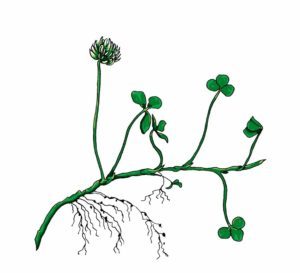
White clover varieties of differ in their leaf and stolon characteristics, and these often quite marked differences help to determine agronomic performance. The latest breeding development has introduced a variety with both stoloniferous and rhizomatous root structures, to aid grazing tolerance, improve drought tolerance and and boost winter hardiness.
Sowing white clover seed
White clover seed is nearly always grown with a companion grass, often with ryegrass. And the type of ryegrass is dependent upon the primary use of the grass sward.
Developments in white clover breeding have increased its versatility and longevity within swards, with greater nitrogen tolerance a key feature in more intensive systems. Sustainable farming systems incorporating white clover range from long term pastures for continuous sheep grazing through to medium-term pastures for rotational sheep or cattle grazing.
Key benefits of white clover
Nitrogen fixation
Rhizobium bacteria that exist symbiotically within protuberances or ‘nodules’ on white clover roots fix nitrogen from the air into a form that can be utilised by the plant. This nitrogen becomes available for companion grasses and/or subsequent forage crops as it's released following plant decay or from the dung and urine of grazing livestock that has grazed on white clover.
In New Zeland, the average nitrogen fixation from white clover is 185 kg N/ha/year, though has the potential to be upwards of 250 kg N/ha/year, depending on factors such as farm system, soil pH and available nutrients.
Intake
The optimal white clover percentage for animal productivity benefits is 20-30%, and approximately 30% for DM yield performance.
Feed value
Response per unit of feed intake is greater for white clover than it is for grass. This higher nutritional value is due to a lower proportion of structural fibre, higher protein content, and more of certain key minerals.
Unlike ryegrass, white clover has the advantage of retaining high digestibility throughout the season because there is continual renewal of leaves and petioles and relatively little stem development.
Soil structure
White clover root systems will improve soil structure and help to overcome problems of soil compaction.
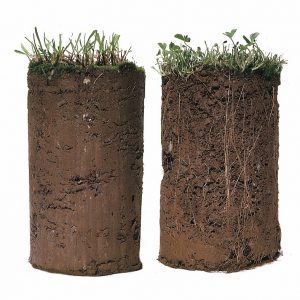
Studies at IBERS have demonstrated improved soil structure that result from a greater white clover component in the grass sward:
- Fertiliser recovery from soils with improved structure was proven to increase from less than 50% to over 75%
- White clover has been shown to significantly decrease the density of soils and increase porosity
- The general movement of nutrients was improved and the result that more grass was produced
Grass-clover balance
The proportion of clover in a grass-clover sward is commonly visually over-estimated, often by twofold. Below, the images should be used as a guide to achieving the optimum balance.
15%
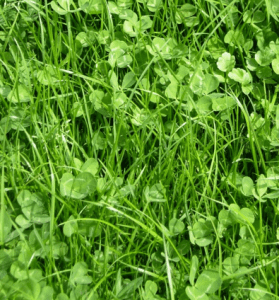
25-30%
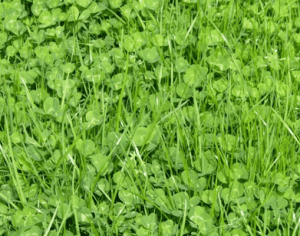
30-50%
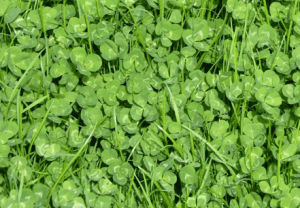
If clover becomes too dominant, then it can out-compete the grass component and unbalance the sward. Unfortunately, this can lead to increased weed ingression and greater vulnerability of the clover to winter damage. This can be common in the second year of a pasture, and a more desirable grass-clover balance will only be seen in the third year and beyond.
Sward composition
Maintaining an optimum DM balance of 30% white clover to 70% grass across the season is the key to grass and clover management, as this is expected to provide the best exploitation of the clover’s nutritional and nitrogen-fixing attributes.
Previously, white clover growth patterns and the interaction with grass have tended to cause significant seasonal variation of clover content in swards – from 5% in the spring up to 60% in summer – but clover breeding work at IBERS is producing varieties that are more compatible with modern ryegrasses and offer more consistent seasonal growth.
Bloat awareness
Bloat is the excessive build-up of gas (carbon dioxide and methane) in the rumen, which can result in distress and possible death due to the exertion of pressure on the animal’s diaphragm, heart and lungs.
Unfortunately, some legumes such as white clover, present an increased risk of bloat. This is due to the rapid breakdown of protein in the rumen.
Effective management procedures to minimise or eliminate the risks of bloat include:
- Limiting access to grass swards when stock is first introduced
- Monitoring livestock
- Feeding high DM forage such as hay/straw prior to turnout
- Avoiding turnout of hungry stock
- Offering hay/straw at intervals (e.g. to dairy cows at milking times)
- Feeding an anti-bloat feed additive
Forging an effective combination
The benefits of combining grass and clover for grazing and conservation are long-established:
- Improved forage quality and feed value due to a boost in digestibility, intake potential, and protein and mineral content of the sward
- ‘Soil structuring’ by white clover root systems that can help to overcome problems of soil compaction
- Reduced reliance on fertiliser due to nitrogen fixation
Accumulated experience and scientific evidence indicate the optimum balance is achieved with a clover content of 30-35% of the total annual DM yield.
Breeding for compatibility
A compatible grass and clover seed mixture is one with a clover content that's large enough to optimise the nutritional and nitrogen-fixing attributes when growing with a high-yielding companion grass.
Grass and clover varieties differ in their aggressiveness towards each other due to their abilities to compete for nutrients, water and light.
Drought tolerance
New clover varieties are emerging from the IBERS breeding programme that are better able to cope with potential climate change scenarios. Improved drought tolerance has been introduced into the breeding programme with the development of hybrids between white clover and Caucasian clover, a drought-tolerant, rhizomatous species.
These new varieties are white clover-like in appearance and combine the agronomic performance with the drought tolerance of Caucasian clover. A further potential advantage of these hybrids is the better persistence of large-leaved varieties under different grassland management systems.
AberLasting is the first white clover variety to be developed at IBERS with rhizomatous root characteristics, which are transferred from the more drought-tolerant Caucasian clover species.
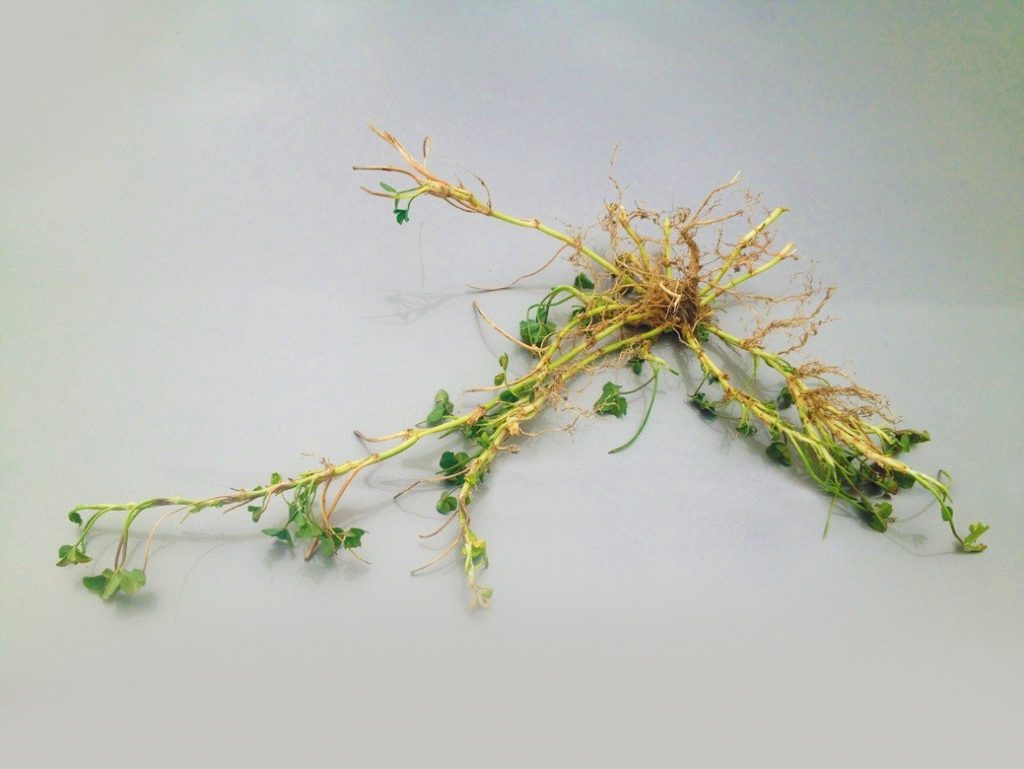
Phosphorous use efficiency
The IBERS white clover breeding programme is developing varieties that can grow in low-phosphorous soils and make better use of the nutrients available. New varieties from the programme, now in trial, are offering the possibility of reducing fertilizer P inputs to swards.
Nitrogen use efficiency
One of the main attractions of white clover is its high protein content, which can be greater than 25% DM. Where conditions are optimum for overall yield, the protein content can exceed the nutritional requirements of grazing ruminants and are lost through their excreta. This can make a significant contribution to overall agricultural losses.
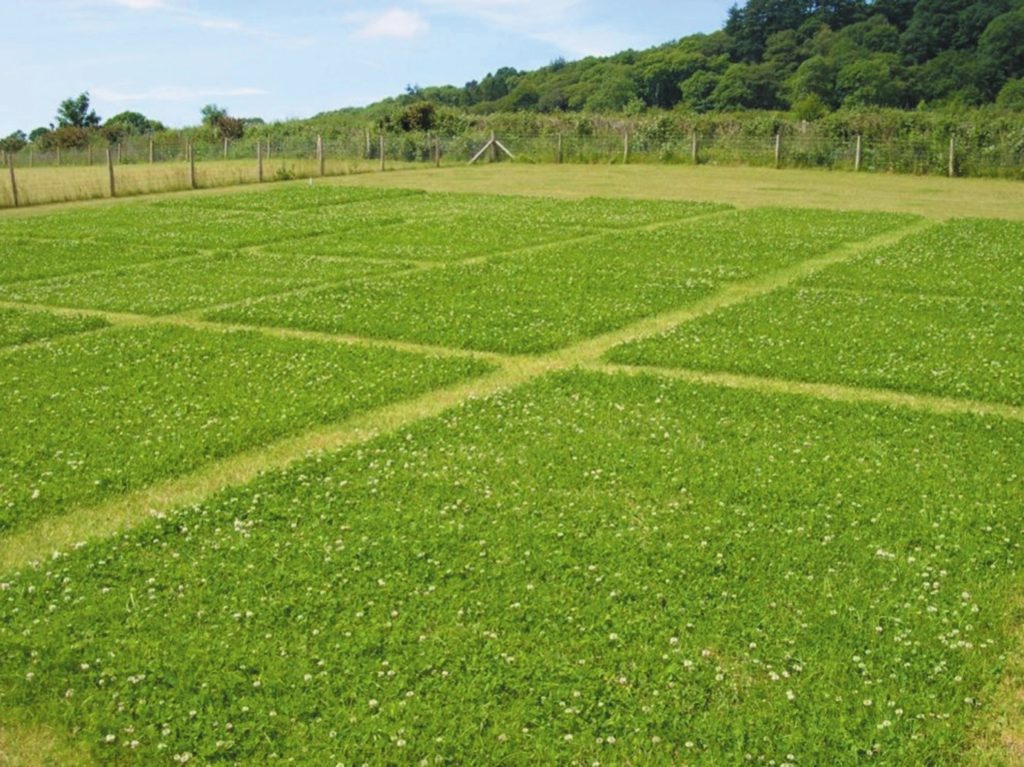
Clovers in sustainable agriculture
- Reduce reliance on fertiliser nitrogen (150-250 kgN/ha/annum)
- Homegrown protein source (25-30% crude protein)
- Enhance summer grazing productivity
- Increase forage intake and enhance nutrient supply
- Fertility building
- Improve soil structure
- Attract pollinators
If you're also considering red clover, this guide can provide you with all of the key info.
